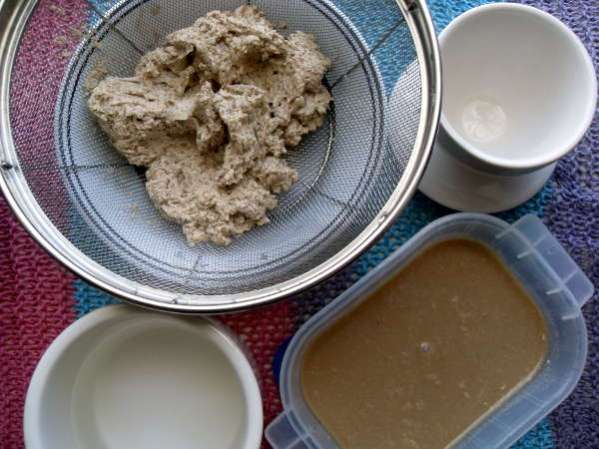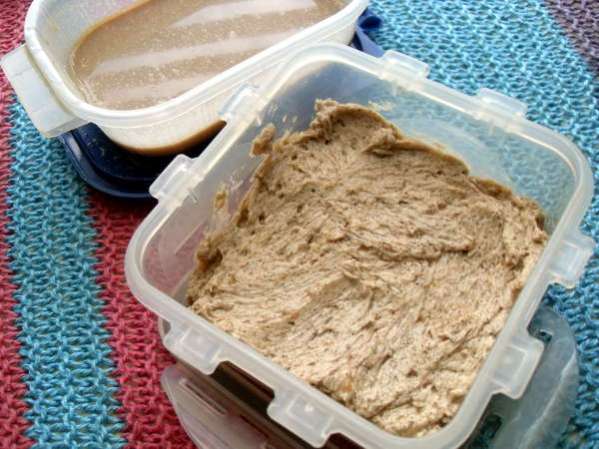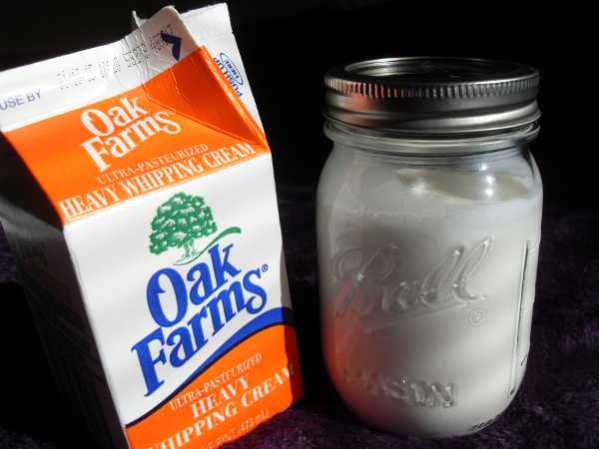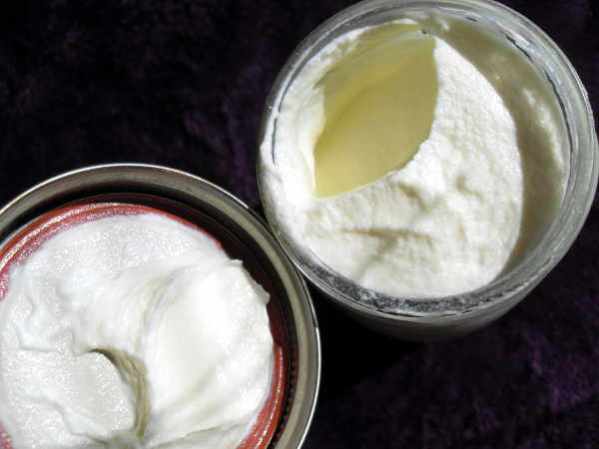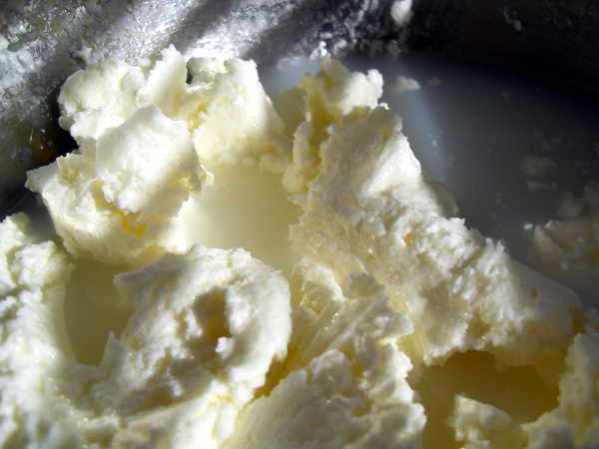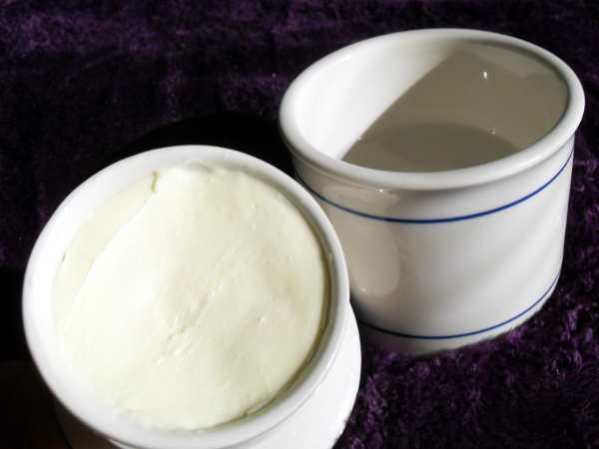I can’t think of a more satisfying feeling than biting into warm, buttery, homemade bread. I love my bread, and I should. I spend a couple of years developing my mad bread-making skills. Every bite of my bread is a reminder of my hard work and success, and my family knows this effort has been out of love. Even when a loaf fails miserably, we still manage to love it somehow, like a family pet that’s all wonky in the brain. Something has been bothering me though. Why do I work so hard and then turn around and smear regular “whatever was on sale” butter on my bread? This must be stopped.
Thankfully, The Magic Teaspoon has some great suggestions for herbal butters, and simple instructions on making your own butter with a blender. I had that, and I also had a brand new little butter bell that hadn’t even been taken out of the box. Butter bells keep your butter fresh while out on the counter at room temperature, allowing you to have spreadable butter whenever you want it. The butter is kept fresh with an air tight seal of water when the bell is closed. I don’t know why it took me so long to get one.
If you like it when newbies post about their clumsy attempts, you are going to love this.
My first attempt was a pumpkin spice flavored butter with the blender. With the cold weather, I love this spice to help soothe my joints and help me face the horrors of chilly air when out running errands. So, I added 1 tablespoon pumpkin spice and 1 tablespoon brown sugar. Next I added some cream (1 cup), and some filtered water straight from the refrigerator (1/2 cup).
After a couple of minutes of blenderizing, I lifted the lid and smoothed it down with a spatula then blenderized again. I also figured out that if I kept the lid tipped ever so slightly and lightly used the spatula to smooth the butter as it was spinning, I could keep he butter churning more easily and the process went much more smoothly. This is how I ended up with butter in my hair.
Next step: drain out the buttermilk.
I had my pretty little butter bell all clean and waiting, and I ended up with fresh buttermilk. Once it drained for a little while, I smoothed it in to my happy little bell, and it promptly fell out. This made me sad. A look at my recipe showed me that I wasn’t supposed to put the water in until the cream was whipped. Oops. I think I ended up whipping a bunch of water into my butter. Sigh.
Later on, browsing for other blender butter recipes on the web showed me that The Magic Teaspoon uses a method where the blender washes the butter for you, which is very convenient. (When I made the mason jar butter, washing the buttermilk out with that chilled water was not very nice to my winter-tender joints.)
Next time I try making butter, I think I’ll use this method again only I’ll do it right this time, and see if I can get my butter to stay in the bell. It might be that the entire method of washing in the blender isn’t right for my butter bell, but I’ll certainly give it a try.
Once chilled the butter was quite firm, though it does dent with a finger pressed into it a little more easily than my store-bought butter.
In the meantime, I had in my hands the first real buttermilk that I had ever seen. Even better, it was pumpkin spice flavored. I saved it for pancakes the next day. This buttermilk was a little watered down due to adding water before draining; recipes that call for buttermilk may need to be adjusted. I used it instead of water in a pumpkin pancake recipe that didn’t call for any buttermilk, and they turned out very nummy and fluffy. You can wash blender butter in a later step and still get buttermilk out of it just like you can with mason jar butter, that just wasn’t the process I used.
By the way, The Magic Teaspoon had several recipes for herbal butters that you can make with store-bought butter, none of them were pumpkin spice but I’ll keep this chapter in mind when playing around with different flavors. The easiest way to make an herbal butter would be to put your ingredients into a blender or a food processor with a stick or two of butter and then blend it all together (or mash the herbs in with the back of a fork), I’m sure I’ll try this as well when I don’t have time to whip up my own butter.
If you want cultured butter (the cream is cultured first with healthy probiotic bacteria), I don’t know if I would add spices. I know that cinnamon and some other spices or herbs with antibacterial properties may interfere with yeast rising (this is why cinnamon breads have the bulk of their spices swirled in the center, so the areas between the swirls are able to rise more). If bread yeast doesn’t like it, probiotic bacteria might not like it either. Who knows though, I’ve seen sourdough starter recipes that include antibacterial herbs and people say they seem to work fine, even though lactobacteria are a part of a sourdough culture. Experiment and see how it goes for you (and maybe let me know).
My next adventure was the cardiovascular muscle toning exercise of mason jar butter. I made butter by shaking a jar and I didn’t even smack myself in the face with the jar. This is a proud moment for me.
I gotta say, this was a lot of fun. Then again, maybe that’s because I loaded some Harry Belafonte onto my mp3 player and danced to the tune of “Jump in the Line”. This had the added bonus of annoying my son by singing “Shake, shake, shake, señora” while he was trying to play video games. It is the right of every mother to annoy their child, and I take my rights as a duty to perform with utmost enthusiasm.
It didn’t take very long before the cream stopped sloshing. I peeked at my whipped cream.
A couple of verses of Belafonte later, my fat began to separate from the buttermilk.
It might be a little tricky to see here, but what I had appeared to be a smooth island of butter floating in a milky pond. I thought it was supposed to look more broken up than that, so I kept shaking, hoping to get little clumps of butter and lots of buttermilky goodness.I was really looking forward to that buttermilk too, seeing as how it wouldn’t be thinned out by the cold water like it was with the blender method I used.
But that is not what happened.
Instead, the buttermilk ended up being whipped right back into the butter. Live and learn. I think I must have shaken for half an hour trying to get my little clumps of butter (and my biceps are a little bit bigger for the effort).
Now I know; when the fats start smacking together and the butter falls from the cream, the time is right to drain and wash even if my butter doesn’t look all clumpy. I might use a bigger jar next time, or leave more room at the top, and see if that helps everything go more smoothly. The next step is to strain out the buttermilk, but mine was all mixed in so I went straight to washing.
All you have to do is pour in some chilled water then squish the water around through the butter with your fingers, and work the butter in a way that is similar to kneading bread. Pour out the milky water, then add more. Repeat this until the water is clear.
Get all the buttermilk out, or as much as possible, as it might make your butter turn rancid more quickly. I had to repeat this step a lot from my newbie clumsiness, but I did end up with clean butter eventually. This time my butter stayed in the bell.
I did have to smooth it level after each use for it to stay in the bell properly, but I was able to use this nice soft butter on my bread for a few days. I had enough to put some in the refrigerator as well. It was light and tasty, and very fun to make (even if things didn’t go exactly as planned).
Somewhere in there, somewhere around when things started becoming solid and started shaking less, I suddenly looked at my jar in amazement. Wait a minute, what magic is this anyway? I know that friction causes heat, and heat can sometimes help certain things dissolve, but I wasn’t trying to make two substances combine in a solution, was I? This was an entirely mechanical process with only one ingredient. How could this be happening? So, I Googled.
It took me about three seconds to find The Science of Whipped Cream and Butter from Food Retro. Apparently butter is made by smacking fat globules together until they stick, and then the water gets pushed out.A little less simplified: water repelling phospholipids surround the fat triglycerides in a layer, keeping the fat in a water repelling bubble. Agitation causes the phospholipids to release their hold on each other (in my head I see something similar to the kid’s game of crack the whip, only the poor phospholipids are screaming in abject terror as they are ripped apart from their friends and loved ones).
As the layer is broken, the fat (triglycerides) in the center break out and seek other fat molecules and cling together for dear life (they so saw what happened to the phospholipids, I don’t blame them for sticking together one bit). When they cling they do so tightly, and the water molecules are forced out.
Serious Eats gets even more nitty gritty, with molecule diagrams and discussion of colloids, and happy or sad faces where the science books usually put a boring positive or negative symbol instead. Man they make science look cute. Also, I didn’t even think about the fact that chemistry might be involved in the process of making a foam for the whipped cream stage, I just chalked it up to mechanical incorporation of air. But oh no, it’s all about the triglycerides.
Hopefully soon I’ll try this again, only I’d like to try culturing my cream first for a probiotic butter. I’m still learning about probiotic cultures, and I’m trying a few things that I’ll share when I’m ready. My first ginger ale didn’t quite turn out like I thought, but my son has frequent stomach issues and last night he tried some. About half an hour later, he said he felt great. I am encouraged, and might be looking at a few methods for getting more healthy bacteria into our diets. Maybe it was just the ginger goodness and its marvelous effect on the digestive system, but I’m hoping that the bacteria can help prevent him from getting so many stomach upsets in the future. Time will tell.
Plus, if I can keep this butter-making up (cultured or not) that’s another area of my life where I’ll be skimming out some preservatives and additives. Also, most of the time when you cut a machine out of the process, you end up with a more sustainable option. It’s a busy world though, and time does get frittered away. I bet though that I find the time every now and then to make a special flavored homemade butter.
There are butter churns that you can put on top of a mason jar, then you spin a crank instead of shaking. I was really tempted to put one on my wishlist and and then drop hints to my man, but looking more closely at the reviews I thought that the ones that hold up well are likely the ones that are way out of the budget. Actually, the less expensive ones were also out of the budget. I suppose if you made a large amount of butter on a regular basis one of these might be a nice tool (perhaps if you owned the cow it came from), but I think I’ll stick to my low-budget options.
There are also molds for homemade butter, both the shape we are familiar with (the rectangle sticks for putting in a butter dish) and cute little shapes like lambs and hearts. Candy and soap molds can be used too, as long as they are food safe materials. Those can be adorable and perhaps one day I’ll get one, but I’ll stick with my butter bell for now.
And some more buttery goodness from other fabulous people:
Karen made an awesome video of mason jar butter making on The Art of Doing Stuff. She seems like a fun kind of lady.
Dana Velden at The Kitchn has a wonderful article with lots of tips, it’s so worth the read that many of the pages I read referenced her.
Here’s a straight from the cow cultured butter kind of article from the lovely people at Mother Earth News. It was a sad day when thrift meant I had to cancel my magazine subscription, but I still enjoy their newsletter emails.
Jill Winger at The Prairie Homestead mentions that the reason store bought butter is so hard is due to a high water content (which also means that you’re buying less butter than you think and spending money on water, but I guess it also means less calories per tablespoon) and uses raw milk from her own cow for her cultured butter. One day I aspire to be so hard core. Very worth the read.
If you’re the kind of person who enjoys reading the first few chapters of cookbooks, where they keep the history and interesting bits about the food (a kindred spirit), you’ll like the article by Jonathan S. White about Churning Cultured Butter at Home.
Ris Lacoste at Fine Cooking has a great looking recipe for Three-Herb Butter. The recipe calls for store bought butter, but of course you can use your own homemade goodness.
Leigh Anne at Your Homebased Mom has a few suggestions for flavored butters, including gift wrapping ideas for the holidays. She’s made some very pretty butters, this is a popular post on Pinterest.
Sonia at The Healthy Foodie has a run-down on making ghee or clarified butter. Besides lasting longer and being easier to use when a recipe calls for softened butter, ghee has a higher smoke point than regular butter. This is important to me because I use a cast-iron aebleskiver pan. When I was using regular butter to brush the wells, my pan got kind of gummy and sticky over time. Switching to ghee made my skillet more clean, and my aebleskiver browned better as well. I’m sure it is also superior for sautéing, I just tend to grab olive oil for that.
I love Lehman’s, and you can find some very old-school supplies in their online shop (not an affiliate link). Their catalog makes great browsing.
If any love of my life might be looking at this and contemplating a special gift for me sometime in the future, those wooden butter molds with the little carved decorations sure do look fun… They’re currently out of stock so you’re likely off the hook for now.



